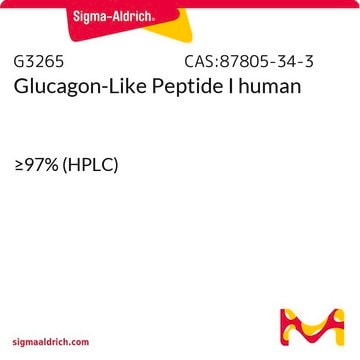추천 제품
product name
Multi Species GLP-1 Total ELISA, EZGLP1T-36K, This Multi Species GLP-1 Total ELISA, EZGLP1T-36K, is used to measure & quantify Glucagon Like Peptide-1 levels in Metabolism research.
Quality Level
종 반응성
human, mouse, rat
포장
kit of 1 × 96 wells
파라미터
20—50 μL sample volume (4hr assay)
assay range
linearity: 90-132%
recovery range: 90-110%
sensitivity: 1.5 pM
(MinDC)
standard curve range: 4.1-1000 pM
inter-assay cv: <12%
intra-assay cv: <5%
기술
ELISA: suitable
입력
sample type cell culture supernatant
sample type plasma (K2 EDTA)
sample type serum
NCBI 수납 번호
UniProt 수납 번호
응용 분야
research use
검출 방법
colorimetric (450nm/590nm)
배송 상태
wet ice
저장 온도
2-8°C
유전자 정보
human ... GCG(2641)
일반 설명
특이성
GLP-1 is conserved in almost all mammals.
애플리케이션
Metabolism
면책조항
신호어
Danger
유해 및 위험 성명서
Hazard Classifications
Acute Tox. 3 Dermal - Acute Tox. 4 Inhalation - Acute Tox. 4 Oral - Aquatic Chronic 2 - Met. Corr. 1 - Skin Sens. 1
Storage Class Code
6.1C - Combustible acute toxic Cat.3 / toxic compounds or compounds which causing chronic effects
시험 성적서(COA)
제품의 로트/배치 번호를 입력하여 시험 성적서(COA)을 검색하십시오. 로트 및 배치 번호는 제품 라벨에 있는 ‘로트’ 또는 ‘배치’라는 용어 뒤에서 찾을 수 있습니다.
이미 열람한 고객
자사의 과학자팀은 생명 과학, 재료 과학, 화학 합성, 크로마토그래피, 분석 및 기타 많은 영역을 포함한 모든 과학 분야에 경험이 있습니다..
고객지원팀으로 연락바랍니다.








